What’s up for 2021?
The number one question we’ve been hearing all fall long has been: “Will Spring 2021 be as good as the one we just experienced?” It’s a question any of us can only guess at—but we can make educated guesses.
I think 2021 will be strong. How strong? Based on what growers and retailers have told me, I think you're safe to plan for it to be half as good as your 2020 spring was. What I mean is, if your 2020 sales were up 20% over plan (or over 2019, depending upon how you measure), then you're safe planning for 2021 to be up 10% over 2019. Note that I did NOT say 10% over 2020. That would be crazy! It would also be a beautiful thing, but I’m not anticipating growth like that.
If you want some reasons why I think that, back in the September GrowerTalks, Abe VanWingerden articulated some of the “tailwinds” that he and his team think will work in our favor for 2021. Nothing has changed since then. They include:
- Fifteen to 20 million new garden consumers, many of whom will come back for more in 2021.
- Travel and entertainment (dining out, sports, concerts, movies) will not be back in any sort of big way by Spring. Folks are going to stick close to home.
- Folks will still be working from home. Some by necessity and some by changes in business, where WFH becomes more of a norm than an exception.
- A chance to plan better going into spring. Hopefully, there won’t be any surprise lockdowns or battling to be deemed “essential.” Spring 2020 got off to a very rocky start, with Easter going into the toilet and retailers scrambling to put up Plexiglas. We won’t have those battles next spring.
One more thing I’d note: With folks sticking close to home, weekday sales could be a strong as weekend sales, taking some pressure off of Saturday and Sunday.
All that said, while you don’t want to leave money on the table, you also don’t want to take excessive risks. For instance, weather might play more of a role in sales than it did for 2020. I would want to have some backup plans in place for selling excess production to regions that need it and I’d want a source for some extra plants in case I run short. Having a network of fellow growers to help you cope with short and long supply is always a good thing.

Heimos poinsettias
Ah, to travel again! And be amongst my industry friends! Even if the travel was just a minivan and the friends were hard to ID because of face masks.
Tuesday of this week, Jen Zurko, Hortistician Marvin Miller and I drove (masked) southwest to Millstadt, Illinois, and the 13th Annual Poinsettia Trials at N.G. Heimos Greenhouses/Millstadt Young Plants. It is our only opportunity this year to see the new and experimental poinsettias, and we weren’t going to miss it just because of a little pandemic.
Not that we were worried. Co-owner Amy Morris did a stellar job providing a safe environment for the attendees—limiting folks to 50 per day (over three days), providing a box lunch, plenty of hand sanitizer and abundant space in which to spread out.
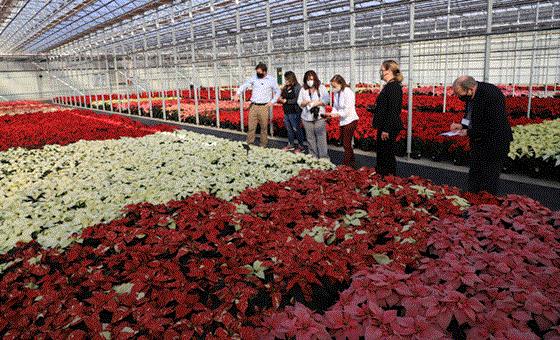
Who are those masked poinsettia enthusiasts?
The trial looked good, with both blackclothed and natural day plants to study. Plants were about a week early, which mirrors what growers across the Midwest and Eastern Seaboard are seeing (see item below on what to do about that).
I counted 173 different varieties in the trial book, including 86 reds, 32 whites, 9 in the “cinnamon” category, 8 marbles, 7 red/white and glitter-type novelties, 3 burgundies and 1 orange.

Orange you glad ...
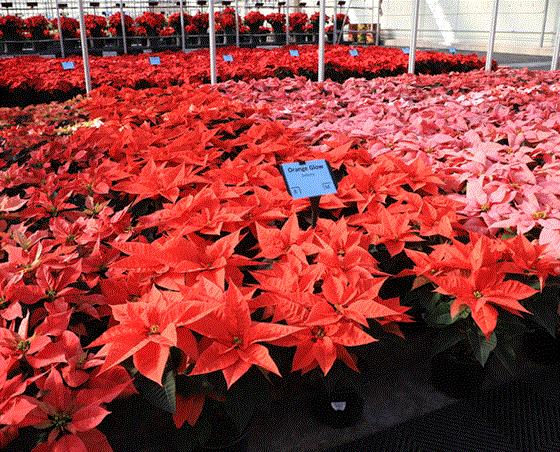
Orange? No, it wasn't Orange Spice (which wasn’t in the trial). This was a new one, Orange Glow, from Selecta, and it was one of the standouts of the trial—not just for its clear, rich orange color, but for the tidy shape of the plant and bracts, and for the fact that it’s a true seedling, not a sport or mutation. It’s early, has medium vigor and “thrives in heat,” Gary Vollmer told us, so is suited for all markets. Gary added that it’s a cross between a traditional poinsettia and another euphorbia species, from whence came the orange color, meaning the breeder may be able to pull out some other interesting orange shades hidden in the genetics.
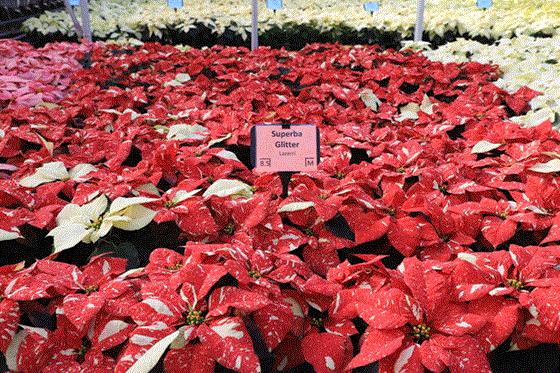
Superba Glitter (Lazerri, via Selecta and Syngenta). First time in North America, it’s a medium-vigor, mid-season glitter type that's a sport of a white variety, not marble like many glitters, meaning when it does happen to revert or mutate, it does so to white, not marble or red, making for a more uniform bench of plants.
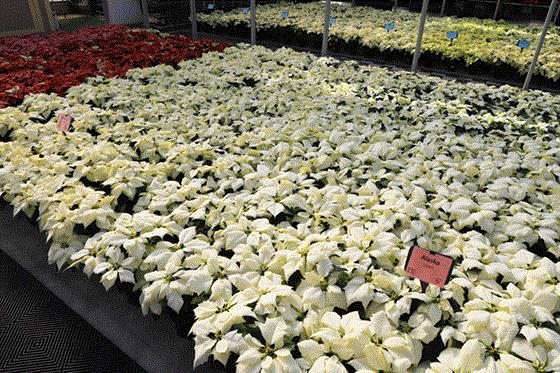
Alpina and Alaska (above) are two bright whites from Lazerri (again, sold through Selecta and Syngenta). Alaska is later and more vigorous. As with all these bright whites, you have to be careful of sprays and water drips on the bracts to prevent possible phytotoxicity or Botrytis.
Corina Hot Pink (left), Candy Bubble Gum (Syngenta). A pair of hot pink poinsettias. Corina is compact and suited for 4- to 6-in. pots. If you need a big one, go for Candy Bubble Gum. Both of these had soft launches last year.

More poinsettias
Virgo White (Beekenkamp and Syngenta). Another good example of the new bright white class of white poinsettias, Virgo is mid- to mid-late season and medium-large in size, good for 6 in. and up. That’s Syngenta’s Technical Services Team Manager Keith Francis showing it off.
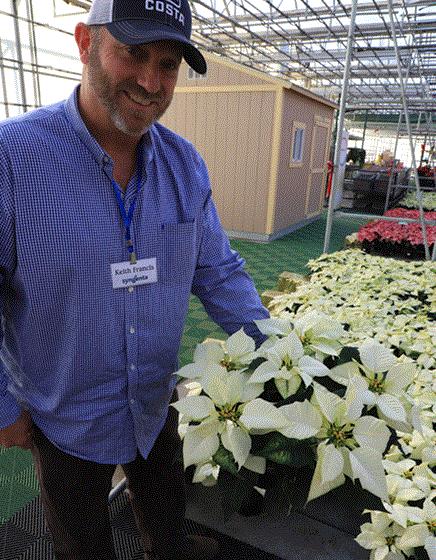
Prestigious Red (Dümmen Orange). If the name sounds familiar that’s because it’s related to Prestige Red and Early Prestige—in fact, it fits right between the two. Dark leafed and said to be very uniform in timing, so you can choose which Prestige you need for your particular timing situation.

J’Adore family (Dümmen Orange). Luv U Pink was, I think, the first hybrid poinsettia on the market. Now Dümmen Orange has a full line of these hybrids called J’Adore, with Pink, Soft Pink, Dark Pink and White Pearl (J’Adore Hot Pink is an existing variety, with a slightly different bract and cyathia). This is a true family, they say, not just a collection; they’re about 25% more vigorous than Suntory’s Princettias, for comparison.

We shot video of all the new introductions, which I will share next time.

And how is your season going, Amy?
It’s amazing to us that Amy and her staff take time (and space) to host this poinsettia trial, considering they’ve got acres of poinsettias to grow and ship—which they were doing as we visited. We asked her how the season was going thus far.
“We’re shipping almost a week earlier than we did last year,” Amy replied. “People are ready for Christmas, so they’re asking us to ship.”
She found that with garden mums, too. “We sold green mums—we were so excited! Heck, that’s how they should go out the door, so people can enjoy them.”
As for numbers, Heimos grew a little more than in previous years, but they’re tight on space so didn’t increase by much. But they’re building 3 to 4 more acres, all for floriculture crops (not for the hemp seed they’re producing), so will be close to 40 acres in size.
Hey, y’all, hold my poinsettia!
Just in time for the warm, sunny weather that brought your crop in early comes this Tech On Demand video on that very topic of holding your poinsettias that started flowering early.

According to those tech experts out in the field, much of the northern hemisphere is five to 10 days ahead of schedule—even two weeks for early blooming varieties. How can you hold poinsettias until your customers want them and still maintain their quality? Technical specialist Nick Flax and Selecta One territory manager James Doukas say it’s all about turning down your ADT—average daily temperature. Plus, you’ve got to deal with night temperature, moisture management, PGR strategies and a few other tricks.
Watch the full 13-minute presentation HERE.
Certified American Grown now a trade association
I believe I mentioned it last time, but now it’s confirmed: Certified American Grown, which had been a marketing arm of the California Cut Flower Commission (their “Field to Vase” dinners were under the CAG umbrella), is now a full-fledged, bonafide independent trade association representing cut flower and greens farmers nationwide. CAG replaces CCFC, which California growers voted to discontinue earlier this year.
As a trade association, CAG will continue its efforts to lobby on behalf of cut flower and greens farmers in Washington, D.C., sponsor American Grown Flowers Month in July, host the annual American Grown Field to Vase Dinner Tour, and give consumers confidence in the source of their flowers and greens by providing the only third-party guarantee in the floral industry validating that the bouquets and bunches purchased were actually grown right here in the U.S.A.
Rita Jo Shoultz, owner of Alaska Perfect Peony, was elected the first Chair of the new organization. Other members of the CAG Formation Board are:
Mike A. Mellano, Mellano & Company, Vice Chair
Ko Klaver, Botanical Trading Company, Secretary
Rene Van Wingerden, Ocean Breeze Farms, Treasurer
Benno Dobbe, Holland American Flowers
Diana Roy, Resendiz Brothers Protea Growers
Lane DeVries, Sun Valley Floral Farms
FJ Trzuskowksi, Continental Floral Greens
Frank Arnosky, Texas Specialty Cut Flower
Michael Genovese, Summer Dreams Farms
Andrea Gagnon, LynnVale Studios
David Register, Fern Trust
Erik Hagstrom, Albin Hagstrom & Son
By the end of the year, the new board will present its vision and goals, including a new 2021 schedule for the American Grown Field to Vase Dinner Tour (which Laurie and I have done twice and it’s fabulous!).
“This will be an innovative group to watch and I look forward to an exciting future for our new, independent association,” said Dave Pruitt, administrator of the association. “We’re excited to continue to connect people to the amazing flowers and greens grown right here in the U.S. and to grow consumers’ bond to a product that connects and brings joy to so many.”
Want to be part of the “refreshed” organization? Reach out to Anna Kalins at info@americangrownflowers.org for more information.

See Dutch cyclamen breeding on YouTube
I keep pointing out that a silver lining to this pandemic nonsense is the ability to travel, via video, to places you’d normally never see. Another case in point: Cyclamen Open Days 2020 by Schoneveld Breeding. They’re in Wilp, the Netherlands, a place I’d wager is not on your radar. But now it can be on your radar—and even on your computer screen—thanks to a collection of short variety videos Schoneveld posted online. These feature detailed looks at … golly, at my count 22 different cyclamen series, from the Micro to the Mammoth! Thankfully, the videos are super quick—the longest is 59 seconds.

And you know what? Host Ton Koers is a fabulous presenter—he should have his own YouTube channel!
Click the image above to access them.
Finally I ...
“The Office Is Dead. Get Yourself a Backyard Shed.” So proclaimed a CNN headline this summer regarding the boom in backyard shed sales. The New York Times published a piece titled “Your New Home Office May Be in the Backyard.” Ellen Wells pointed out the trend to us, having heard the same on her local news (in which a woodworking company claimed sales up 40% to 60% over last year). It’s not new news; ShedBuilder magazine was reporting record sales for its readers all the way back in April, so the shed boom started early in the pandemic.
The reason? The need for additional at-home workspace—whether for an office or schoolroom or, hey, maybe just a place for the grownups to escape for some adult beverage time!
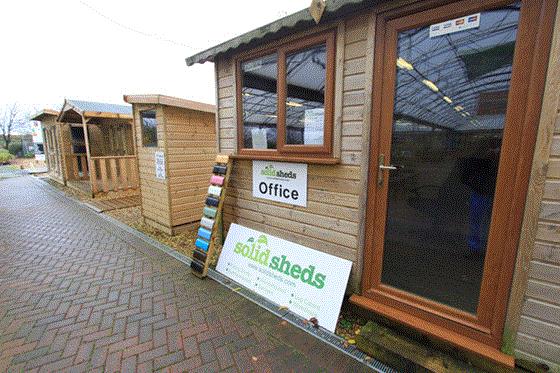
My first thought was: “Garden centers can sell sheds and nice ones!" I know that from having seen fabulous shed yards at many European garden centers (like the one above). These are not flimsy, ugly boxes for rakes and mowers; these are snappy little wooden getaways for relaxing, puttering, entertaining—and yes, working or studying. Equipped with a (safe) heater, they can probably make a cozy study nook even in a cold clime.
However, while it may be too late to create and stock an entire backyard shed department, it is NOT too late to create a backyard shed DECORATING department. Because a shed without a beautiful landscape and hardscape around it, and plenty of houseplants and garden-inspired décor inside is, well, not much more than an outhouse.

Finally II ...
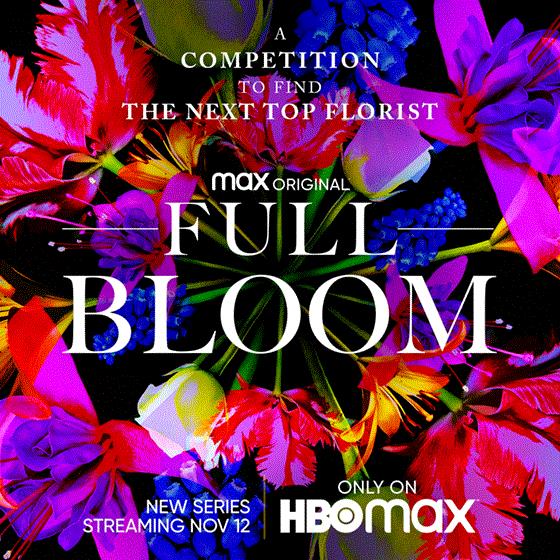
Remember that show I mentioned last week, "Full Bloom," that's airing on HBO Max? I just learned that Mellano & Company of Oceanside, California, was the top floral and greens provider for the show. Their PR person Sonja shared that info.
Said Sonja in her email to me, "Although it has been a long and pivoting road through COVID, it was a terrific opportunity to showcase both the farm and wholesale products of Mellano. When the events world came to a halt, it was truly a great opportunity for the brand."
That was certainly a point I hadn't considered. The cut flower industry hasn't shared in the bounty of the gardening boom that most of the rest of the industry has enjoyed, so any additional way to promote the benefits of cut flowers is a good thing!
Remember, be positive but test negative!

Chris Beytes
Editor
GrowerTalks and Green Profit
This e-mail received by 22,203 loyal readers!
Thanks to my loyal sponsors, who help me reach the 21,894 readers of Acres Online in 66 countries. Want to be one of them (a sponsor, that is)? Give Paul Black a shout and he'll hook you up.